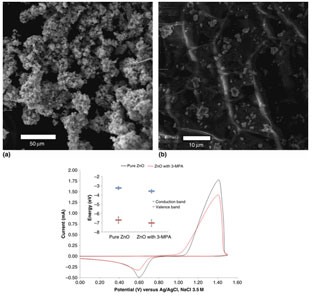Published online by Cambridge University Press: 20 April 2016

We analyze the effect of functionalization in the surface of zinc oxide crystal structure by 3-mercaptopropionic acid. X-ray powder diffraction data and extended x-ray absorption fine structure studies confirms a wurtzite structure. However, the morphology of the surface seems to be reduced and shows a film-like surface as demonstrated by x-ray absorption near edge structure and scanning electron microscopy. As a result of surface functionalization, the energy levels of the semiconductor were shifted toward reductive potentials (by 50 mV) as determined by diffuse reflectance and cyclic voltammetry.